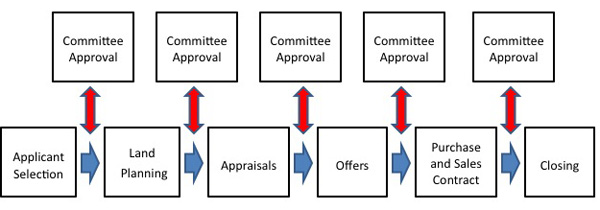Process/Timeframe
“Acquisitions” encompasses the period between application selection and the real estate closing. The diagram below depicts WAC’s acquisition process from application to closing (payment). It consists of six (6) distinct phases: Applicant Selection, Land Planning, Appraisal, Offer, Contract for Purchase and Sale, and Closing. Easement Committee approval is required at every stage of the acquisition process. The committee meets monthly to review and vote on projects as they advance through the acquisition process.

Once an applicant is approved, design of a conservation easement usually takes several months depending on the size of a property, nature of agricultural or forestry operations, and potential estate planning, title, or ownership complications. WAC’s Easement Committee must approve the drafted design (based on WAC’s Land Planning Guidelines). The thresholds established in the guidelines may not be appropriate for all properties; CE Program staff and committee members do have some flexibility in the development of a plan. Once the design is approved, the proposed conservation easement is appraised to determine its Fair Market Value (“FMV”). WAC pays for the appraisal and the staff time required to design a proposed conservation easement. Landowners (and their families) are especially encouraged to be actively engaged in the Land Planning stage.
The appraised value of the conservation easement becomes the basis for the Offer. Generally speaking, the Offer (purchase price) is the difference between the land’s value with the easement and its value without the easement. A landowner receives six months to decide whether or not to accept. WAC strongly encourages landowners to seek financial and legal advice from a qualified financial planner and attorney during this time (before signing a Contract for Purchase and Sale).
If a landowner accepts WAC’s offer, a Contract for Purchase and Sale is signed and the decision to sell a conservation easement becomes binding. The duration of the contract is typically one year. The landowner receives a three-percent downpayment, with the remaining 97 percent of the conservation easement value paid at Closing.
While in contract, CE Program staff work with the landowner and contractors to complete a metes and bounds survey of the property, an Environmental Site Assessment (Phase I), Title Search / Commitment to Title Insurance, and municipal review. WAC pays for the cost of these services.
After Closing occurs and WAC acquires the conservation easement (by means of executing the Deed of Conservation Easement), the stewardship phase begins. CE Program staff inspect the property annually and work with the landowner to review, and if necessary seek approval for, reserved right requests, to clarify expectations and obligations associated to the easement language, and to facilitate any other instance where CE Program staff could benefit property management. WAC becomes a partner on your land. Additionally, after the Closing is complete, New York City pays a proportion of the property tax bills to local taxing authorities.
